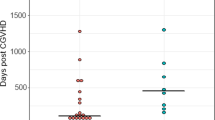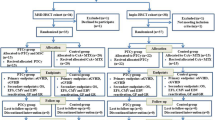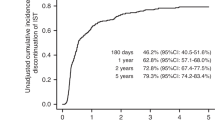Abstract
We compared chronic graft-versus-host disease (cGvHD) following umbilical cord blood (UCBT) and matched sibling donor peripheral blood transplant (MSD). 145 patients (2010–2017) with cGvHD after MSD (n = 104) and UCBT (n = 41) were included. Prior acute GvHD was less frequent in MSD (55% vs. 85%; p = 0.01). Severe cGvHD (32% vs. 15%, p = 0.01) and de-novo onset (45% vs. 15%, p < 0.01) were more frequent following MSD. Liver was more frequently involved in MSD recipients (38% vs. 6%); and GI in UCBT (33% vs. 63%), both p < 0.01. Overall response (CR + PR) was similar between both cohorts. 2-year CR was higher in UCBT (14% vs 33%, p = 0.02). Karnofsky score (KPS) ≥ 90 at cGvHD diagnosis was associated with higher odds of response (95%CI: 1.42–10, p < 0.01). The cumulative incidence of durable discontinuation of immune-suppressive therapy, failure-free survival (FFS) and NRM at 2-years were similar between cohorts. KPS < 90 (95%CI: 3.1–24.9, p < 0.01) and platelets <100 × 10e9/L (95%CI: 1.25–10, p = 0.01) were associated with higher risk of NRM. UCBT patients were more likely to have a prior acute GvHD, less severe cGvHD and more likely to attain CR. Despite differences, both cohorts had similar NRM and FFS. High-risk groups, including those with platelets <100 × 10e9/L and KPS < 90, need careful monitoring and intensified therapy.
Highlights
-
cGvHD after UCBT was less severe, and had more CR to therapy than MSD transplant.
-
NRM was similar in patients with cGvHD after UCBT and MSD transplant.
-
FFS was similar in patients with cGvHD after UCBT and MSD transplant.
This is a preview of subscription content, access via your institution
Access options
Subscribe to this journal
Receive 12 print issues and online access
$259.00 per year
only $21.58 per issue
Buy this article
- Purchase on SpringerLink
- Instant access to full article PDF
Prices may be subject to local taxes which are calculated during checkout




Similar content being viewed by others
References
Arai S, Arora M, Wang T, Spellman SR, He W, Couriel DR, et al. Increasing incidence of chronic graft-versus-host disease in allogeneic transplantation: a report from the Center for International Blood and Marrow Transplant Research. Biol Blood Marrow Transpl. 2015;21:266–74.
Inamoto Y, Flowers ME, Sandmaier BM, Aki SZ, Carpenter PA, Lee SJ, et al. Failure-free survival after initial systemic treatment of chronic graft-versus-host disease. Blood. 2014;124:1363–71.
Pidala J, Kurland B, Chai X, Majhail N, Weisdorf DJ, Pavletic S, et al. Patient-reported quality of life is associated with severity of chronic graft-versus-host disease as measured by NIH criteria: report on baseline data from the Chronic GVHD Consortium. Blood. 2011;117:4651–7.
Flowers ME, Inamoto Y, Carpenter PA, Lee SJ, Kiem HP, Petersdorf EW, et al. Comparative analysis of risk factors for acute graft-versus-host disease and for chronic graft-versus-host disease according to National Institutes of Health consensus criteria. Blood. 2011;117:3214–9.
Frey NV, Porter DL. Graft-versus-host disease after donor leukocyte infusions: presentation and management. Best Pr Res Clin Haematol. 2008;21:205–22.
Higman MA, Vogelsang GB. Chronic graft versus host disease. Br J Haematol. 2004;125:435–54.
Newell LF, Flowers ME, Gooley TA, Milano F, Carpenter PA, Martin PJ, et al. Characteristics of chronic GVHD after cord blood transplantation. Bone Marrow Transplant. 2013;48:1285–90.
Styczynski J, Tridello G, Gil L, Ljungman P, Hoek J, Iacobelli S, et al. Impact of donor Epstein-Barr virus serostatus on the incidence of graft-versus-host disease in patients with acute leukemia after hematopoietic stem-cell transplantation: a study from the acute leukemia and infectious diseases working parties of the European Society for Blood and Marrow Transplantation. J Clin Oncol. 2016;34:2212–20.
Kanakry CG, O’Donnell PV, Furlong T, Lima MJD, Wei W, Medeot M, et al. Multi-Institutional study of post-transplantation cyclophosphamide as single-agent graft-versus-host disease prophylaxis after allogeneic bone marrow transplantation using myeloablative busulfan and fludarabine conditioning. J Clin Oncol. 2014;32:3497–505.
Mohty M, Malard F. Antithymocyte globulin for graft-versus-host disease prophylaxis after allogeneic hematopoietic stem-cell transplantation. J Clin Oncol. 2017;35:3993–5.
Gutman JA, Ross K, Smith C, Myint H, Lee CK, Salit R, et al. Chronic graft versus host disease burden and late transplant complications are lower following adult double cord blood versus matched unrelated donor peripheral blood transplantation. Bone Marrow Transpl. 2016;51:1588–93.
Kanda J, Nakasone H, Atsuta Y, Toubai T, Yokoyama H, Fukuda T, et al. Risk factors and organ involvement of chronic GVHD in Japan. Bone Marrow Transplant. 2014;49:228–35.
Konuma T, Tsukada N, Kanda J, Uchida N, Ohno Y, Miyakoshi S, et al. Comparison of transplant outcomes from matched sibling bone marrow or peripheral blood stem cell and unrelated cord blood in patients 50 years or older. Am J Hematol. 2016;91:E284–E92.
Barker JN, Weisdorf DJ, DeFor TE, Blazar BR, McGlave PB, Miller JS, et al. Transplantation of 2 partially HLA-matched umbilical cord blood units to enhance engraftment in adults with hematologic malignancy. Blood. 2005;105:1343–7.
Jagasia MH, Greinix HT, Arora M, Williams KM, Wolff D, Cowen EW, et al. National institutes of health consensus development project on criteria for clinical trials in chronic graft-versus-host disease: I. The 2014 Diagnosis and Staging Working Group report. Biol Blood Marrow Transpl. 2015;21:389–401.e1
Lazaryan A, Arora M. Evolving concepts in prognostic scoring of chronic GvHD. Bone Marrow Transpl. 2017;52:1361–6.
Lee SJ, Wolff D, Kitko C, Koreth J, Inamoto Y, Jagasia M, et al. Measuring therapeutic response in chronic graft-versus-host disease. National Institutes of Health consensus development project on criteria for clinical trials in chronic graft-versus-host disease: IV. The 2014 Response Criteria Working Group report. Biol Blood Marrow Transpl. 2015;21:984–99.
Ponce DM, Gonzales A, Lubin M, Castro-Malaspina H, Giralt S, Goldberg JD, et al. Graft-versus-host disease after double-unit cord blood transplantation has unique features and an association with engrafting unit-to-recipient HLA match. Biol Blood Marrow Transpl. 2013;19:904–11.
Scott BL, Pasquini MC, Logan BR, et al. Myeloablative versus reduced-intensity hematopoietic cell transplantation for acute myeloid leukemia and myelodysplastic syndromes. J Clin Oncol. 2017;35:1154–61.
Pidala J, Vogelsang G, Martin P, Chai X, Storer B, Pavletic S, et al. Overlap subtype of chronic graft-versus-host disease is associated with an adverse prognosis, functional impairment, and inferior patient-reported outcomes: a Chronic Graft-versus-Host Disease Consortium study. Haematologica. 2012;97:451–8.
Carpenter PA, Logan BR, Lee SJ, Weisdorf DJ, Johnston L, Costa LJ, et al. A phase II/III randomized, multicenter trial of prednisone/sirolimus versus prednisone/ sirolimus/calcineurin inhibitor for the treatment of chronic graft-versus-host disease: BMT CTN 0801. Haematologica. 2018;103:1915–24.
Lee SJ, Nguyen TD, Onstad L, Bar M, Krakow EF, Salit RB, et al. Success of immunosuppressive treatments in patients with chronic graft-versus-host disease. Biol Blood Marrow Transpl. 2018;24:555–62.
Arora M, Klein JP, Weisdorf DJ, Hassebroek A, Flowers ME, Cutler CS, et al. Chronic GVHD risk score: a center for international blood and marrow transplant research analysis. Blood 2011;117:6714–20.
Author information
Authors and Affiliations
Corresponding author
Ethics declarations
Conflict of interest
DJW - research support from Incyte. JEW - advisor at Magenta Therapeutics. BRB - founder of Tmunity Therapeutics, advisory board member for Kadmon Pharmaceuticals, Magenta Therapeutics, and BlueRock Therapeutics and receives research funding from BlueRock Therapeutics. SGH – consultant for Incyte, Bristol Meyers Squibb, and Generon.
Additional information
Publisher’s note Springer Nature remains neutral with regard to jurisdictional claims in published maps and institutional affiliations.
Rights and permissions
About this article
Cite this article
Okoev, G., Weisdorf, D.J., Wagner, J.E. et al. Outcomes of chronic graft-versus-host disease following matched sibling donor versus umbilical cord blood transplant. Bone Marrow Transplant 56, 1373–1380 (2021). https://doi.org/10.1038/s41409-020-01195-5
Received:
Revised:
Accepted:
Published:
Issue date:
DOI: https://doi.org/10.1038/s41409-020-01195-5
This article is cited by
-
Overlap chronic GVHD is associated with adverse survival outcomes compared to classic chronic GVHD
Bone Marrow Transplantation (2024)
-
Impact of HLA disparity on overall mortality risk in patients with extensive chronic GVHD: The HLA Working Group of Japanese Society for Transplantation and Cellular Therapy
Bone Marrow Transplantation (2023)



